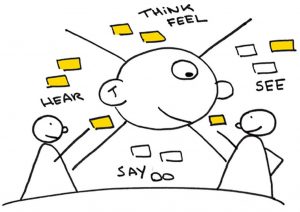An example of a facilitator
Everything listed above seems obvious enough: it is important to write down opinions, to remain neutral, to develop a plan, to formulate goals – the tasks are clear, so why are they not solved in practice without outside help? The reason is the lack of a structured approach and lack of awareness of the tools for organizing a meeting.
Take, for example, a typical meeting with the topic “Next week’s work plan” – an hour-long meeting that many companies have. Let ten people participate in it, one from each department. I am sure that in half an hour after the start there will be the following picture:
- Two people are actively discussing some highly specialized issue that concerns only their departments / projects;
- Two others try to follow what is happening, but slowly miss the point of the discussion;
- The three pretend to be collected and put to work, but in reality they are just waiting for the end of the meeting;
- Three more are frankly bored, thinking about something of their own or reading messages in instant messengers.
The productivity of such a meeting is very low: an hour of time is spent, but it took about ten minutes from this hour to actually work on key issues. The reason is that the monotonous activity – “one speaks, the rest listen” – quickly tires. This is how the human brain works: in order to maintain concentration and efficiency, we need to change the formats of activity.

Knowing this, the facilitator alternates between different types of activity:
- Voice discussion: a standard format in which everyone speaks on key issues. The facilitator ensures that no one deviates from a given topic, such as next week’s work plan, and ensures that everything said is recorded in a visual access area for all participants (for example, shorthand is taken on a laptop and its results are broadcast on a large screen);
- Written discussion: a question is asked, such as “what do you consider to be a priority task for the next week?” – and the participants respond to it in writing. In notebooks, on stickers, in chat: the main thing is that everyone writes and then simultaneously shows the results. We get a transparent cut of opinions, avoiding a situation where the first speaker sets the vector of thinking and inclines the rest in his favor;
- Working with visualization For example, there is a discussion of the work of different departments – we draw a “pizza” on the board, in which each piece corresponds to one department. Next, we invite the participants to evaluate the work of each department on a scale from 1 to 5 on stickers, and then simultaneously attach these stickers to the board by department. We get structured data that can be discussed;
- Voting. It is important to maintain high dynamics here: have you formed a draft plan for the week? Ask them to rate this plan on a scale of one to five, how many fingers they raised – that’s the rating. In 30 seconds you will get an idea of whether the participants think the plan is successful or not, you can move on to the discussion.
By alternating these formats with each other, you will keep the energy of employees and their involvement at a high level. And these are just four tools: simple, understandable, but almost no one uses them. In general, all facilitation methods look simple, but only after you are told about them. This is the main advantage of the methodology: it is very easy to apply.
Who needs facilitation
I completed training in facilitation in 2015, accredited as a facilitation trainer in 2017, and re-accredited to take into account the transition to remote work due to the coronavirus pandemic in 2020.

Here are some examples from my practice and from the leaders I have trained:
- A manufacturing company orders an eight-hour session on finding growth points in business processes and optimizing the company’s work. The composition of the participants is more than 100 people. At lunchtime, the leader has to leave urgently, but due to the fact that the meeting is prepared in detail and the process is launched, the group reaches the goal without escort. Had it been a regular policy meeting, it would have had to be cancelled;
- The entire top management of the chemical production undergoes facilitation training (along with a number of other modern practices), changes the format of working with teams, as a result of which the company grows in revenue by 40% during the year;
In a marketing agency, after learning the method, they change the format of regular monthly meetings, the next one, already using facilitation, passes twice as fast as usual, and the team is inspired because they learn that “meetings, it turns out, can charge”;
In the bank, after the training of managers, the time of daily meetings in three teams is reduced by 15–20 minutes, which leads to direct payroll savings in only one department in the amount of about 4.2 million rubles a year.
We conducted a survey on executive satisfaction with the quality and results of traditional meetings, and the results were disappointing: 70% believe that meetings drag on, fall short, or lose out on the quality of decisions. If you are in that 70%, facilitation is your choice. Take care of your owls meetings for real, turn them into an event that you want to go to, in which you want to participate, and you will see how the productivity of your employees will grow by an order of magnitude.
